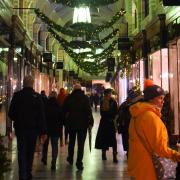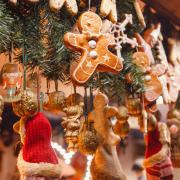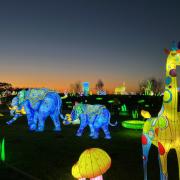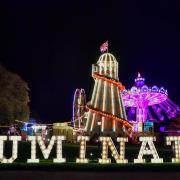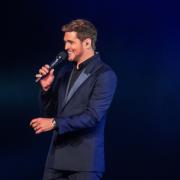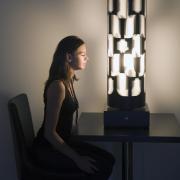Pale mushrooms shimmer into lilac and yellow fairyland fantasies, spiders step out in turquoise, dark lichens sizzle to dazzling orange and nettles glow blue and pink.
An extraordinary world colours usually invisible to the human eye, is being unlocked by David Atthowe, who has found a way of revealing the multicoloured life of many of our most familiar (and sometimes seemingly drably-coloured) plants and animals.
Suddenly an inconspicuous lichen, insect or fungus turns bright blue, green, pink, yellow or red, and an evening walk through woodland becomes a psychedelic trip into a glowing wonderland.

David is unleashing the phenomenon of biofluorescence, shining an ultraviolet torch on plants and minibeasts and watching the natural world respond with a dramatic light show in the vibrant colours they would appear if humans had the ultraviolet vision many other animals possess.
‘When I first saw it my reaction was ‘Wow!’ And that’s the reaction of everyone I show, ‘Wow! Woah!’’ said David. ‘I feel like a magician!’
As he conjures an extraordinary spectacle from a damp, twilit evening on Mousehold Heath, just outside Norwich, he explains how he came across biofluorescence just a year ago and now leads biofluorescence walks across Norfolk.

‘How could you find something like this and not want to share it?’ asks David, who has loved nature all his life.
He grew up in Thorpe St Andrew, near Norwich. His dad is a car mechanic and his mum a nursery teacher. David went to Thorpe St Andrew High School and when a school careers adviser asked what he liked doing he mentioned his Saturday job at Pets at Home. It led to a college course in ornamental fish management and then work experience, aged just 17, in Borneo, rearing freshwater dragon fish – metre-long beauties which sell for an astonishing £20,000-plus each.
David fell in love with Indonesia, and travel in general and was living in Australia, working delivering leaflets, when a relationship broke down. ‘I was walking 50km a day delivering leaflets and a friend said you are going so far you could walk across a country. So I did! I went back to Indonesia and walked 1,100km.’

It was the start of Nomadic Lion, an international walking movement he launched a decade ago. ‘We walk to share happiness and joy with all,’ he said. He crossed India on a 10-month walk with little more than a hammock, mosquito net – and his belief in the goodness of people and desire to connect with them. ‘The most scary part is traffic. If I meet a cobra I’m excited, but I’ve had some very near misses with traffic!’ said David.
Each walk supports a positive project – sustainable, organic farming in India, environmental issues in Borneo - and the charity Musical Keys, which helps disabled children enjoy music, on a 21-day walk across Norfolk.
‘I thought it might be harder to do in Norfolk, in Britain, but it wasn’t at all,’ he said. ‘Wherever you go in the world, if you knock on the door and ask for a bottle of water, no-one will turn you down. Wherever we were, people came up to us and asked where we were going.’

Eager to share the joy he found in nature he began leading walks focusing on scents, microscopic wildlife or forest bathing (finding calm and peace in woodland).
And then, a year ago, he discovered biofluorescence. Watching an online talk about praying mantis, there was a comment about it changing colour under ultraviolet light. Intrigued, he decided to find out more and was astonished to discover it was true of many plants and animals.
‘At first I thought this can’t be true!’ said David, with his trademark huge smile. In humans, it is mainly our nails and teeth which fluoresce - completely fitting for David’s mega-watt beam, even in ordinary, non-ultraviolet light.

As we walk lichen flames from familiar green to fiery orange, caterpillars glow blue and green, dark algae climbing tree trunks turns red, a pale mushroom takes on a blue cap and yellow stalk and the normally almost-invisible networks of mycelium, connecting fungus blooms across the woodland, shine bright blue. David hunts for a common beige and grey leopard slug to show how, if he touches its back it emits a substance which glows bright yellow under ultraviolet light – then turns blue after 30 seconds. ‘I guess it’s a defensive thing,’ he said.
He explains that as ultraviolet light is shone on a biofluorescent object it bounces back at a wavelength humans can see. David said 90 per cent of songbirds exhibit biofluoresence – with males and females which might look indistinguishable to us, lighting up in different colours and patterns. ‘Some flowers look like they have landing lights for insect pollinators!’ said David.
Rockpools are a multicoloured wonder and the spikes of hedgehogs turn bright blue.
‘Sonic the hedgehog is real!’ said David, ‘And the glowing jungle in Avatar!’

He now explores biofluorescence everywhere from Norfolk to the Malaysian rainforest, leading biofluorescence night walks across the county including Mousehold Heath and Whitlingham Country Park, near Norwich, Broadland Country Park, north of the city, Deepdale Farm, Burnham Deepdale and west Runton on the north coast and Hoveton Great Broad near Wroxham.
‘I’m the only person in Europe doing it,’ said David.
‘There is nothing more fulfilling than seeing someone’s face light up in wonder when they see biofluorescence for the first time. Nature is full of magic just waiting to be discovered.’
David will be leading biofluorescence walks on Mousehold Heath on February 7 and 29, and dates from March at sites including Mousehold Heath, Eves Farm, Booton, near Reepham and Boston Square Sensory Park, Hunstanton. For full details visit revealnature.co.uk











